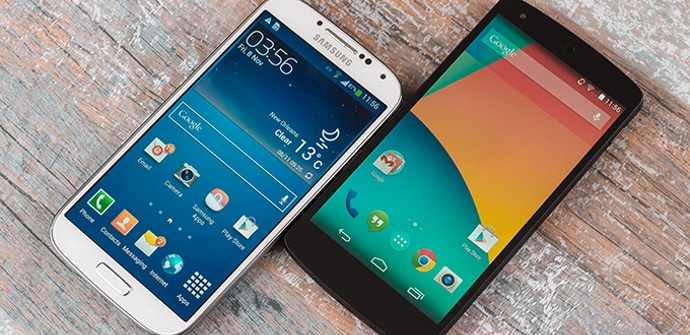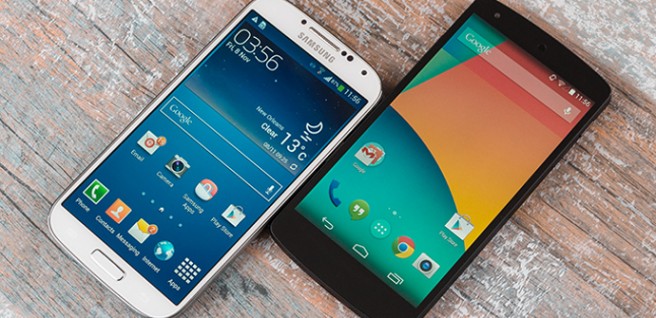
Today we collect a couple of videos that closely examine the performance of two of the most popular terminals on the market today, the Google Nexus 5 and Samsung Galaxy S4. We will review most of its characteristics (screen, performance, software, design, etc.) to analyze which of the two teams stands out from the other in each section.
There is no doubt that the Galaxy S4, in commercial terms, it is one of the smartphones major of this 2013, managing to become, just behind its predecessor the, S III, in the most used device of the Android platform right now. However, Nexus terminals are always a reference for embodying the google philosophy, the head of the ecosystem. Thus, this comparison focuses on two teams of great importance.
Design, size and manageability
The Nexus format is slightly longer and narrower than the Galaxy S4, however, if we see them face to face, we can appreciate that the differences are minimal and not very relevant when holding both teams in hand. In terms of weight, they are also very on par.
The big difference is found in the materials used by each product. Samsung is equipped with a plastic (removable) case considerably more bright and similar to that of the rest of the Galaxy teams, while Google and LG have opted for plastic soft touch (with more grip, but more prone to accumulating footprints), which also seems to be turning into a identity sign of the Nexus family.
Screens, inches, pixels, and density
The Galaxy S4 has a slightly larger screen, of 4,99 inches to be precise, at 1080p, which offers a rate of 441 dpi. It is a Super AMOLED, a type of display technology that generates hate and love in equal measure. The strong saturation it is perhaps its most characteristic feature.
El Nexus 5 it also has a privileged, high-quality screen, albeit a little smaller, with 4,95 inches. Your rate of dots per inch is somewhat higher, 445 dpi. The qualities of the panel are similar to those of the LG G2, so we can expect a great performance in this regard.
Performance, speed and responsiveness
The Samsung terminal uses a Snapdragon 600 at 1,9 GHz, that is, the fastest processor at the time the device appeared on the market. The heavy cloak of TouchwizHowever, it causes a somewhat deficient responsiveness. In the same video we can see true lag when controlling the equipment.
El Nexus 5, meanwhile, uses a Snapdragon 800 to 2,3GHz and it offers one of the fastest and smoothest user experiences on the market, also thanks to the lightness of its operating system.
Autonomy, two disparate teams
Perhaps this is not the most prominent aspect of the Google terminal, since it is equipped with a battery pretty basic in terms of load capacity, of 2.300 mAh, and not removable. On the contrary, the Galaxy S4 has 2.600 mAh and the part can be replaced so, carrying a battery of replacement, we will enjoy an extremely long autonomy.
Camera: megapixels and optical stabilizer
No matter how many turns we give it, it still seems to us that the resolution in which a camera is able to capture the image is a fundamental factor, although not the only important one. In this sense, the Galaxy S4 is above with its sensor 13 Mpx (compared to the 8 Mpx of its competitor). Maybe he Nexus 5 is superior when taking pictures with poor light environmental, thanks to its optical stabilizer, but in all other respects we should surely declare the Samsung device the winner.
Operating system, TouchWiz vs Pure Android
Samsung has a huge variety of proper functions that can turn your S4 into a terminal with more possibilities when it comes to controlling it, however, are all of them really useful or simple virguerías that are forgotten during daily use and overload the system? In short, it is not a question with an easy answer and it will depend on the experience of each one, but many people ask themselves.

El Nexus 5 It has much more basic tools, although with more powerful options to control Google Now. Its philosophy stems from simplicity and, from the third-party software that we find in the Play Store, we can add to the system an innumerable amount of accessories.